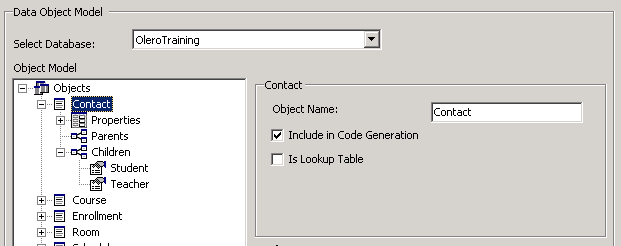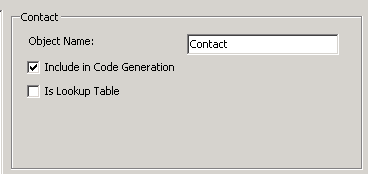
Single click on an Object within the tree view to view the settings which can be modified. The object that is selected expands to show the Column Properties, Parents and Children that reference it. In this context the select object is considered the Root object. For example, the Contact table object is considered the Root object below. Student and Teacher are listed as Children of the Contact.

If you expand the Teacher object under the Objects node Teacher is now considered the Root object and Contact is listed as a Parent of Teacher.

The settings available which control the behavior of a selected table object are explained below.

Object Name: Default: Mapped Database Table Name
The default name for each object is the name of the table the object maps to. This setting allows the developer to choose a different name for the object in cases where the table name is not desirable. For example naming conventions such as TblCustomers.
Note: Object and table names cannot include spaces or special characters, or numbers which are not allowed by the C# language. ORM.NET will validate all object and property names when you first connect to the database.
Note: We recommend keeping all table names singular and to avoid using spaces for table and column names when designing your database schema. This will make the generated Data Layer easier to read and understand.
Include in Code Generation: Default: Enabled
Enabling this checkbox indicates that you want this object to be included when the data layer is generated. By default all tables will be included when the data layer is generated. There may be cases where it does not make sense to expose a table within the data object model in a schema such as a temporary working tables or unused tables which have been included in the schema.
Is Lookup Table: Default: Not Enabled
This feature is designed for objects which map to tables that contain static or read-only information which does not frequently change . When the data layer is generated all tables which have been enabled as Lookup objects will be wrapped in a separate ADO.NET data set from the transactional data set. This feature allows developers the flexibly to independently cache this data in memory at the application or session level to improve performance.
An example of tables that might make good Lookup objects which map to tables which list Countries or States. See the Lookup Table Objects section to learn more about using Lookup Objects to retrieve and display data.